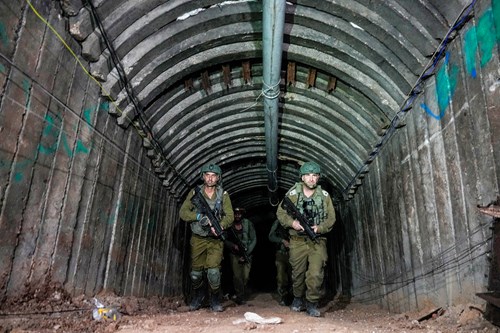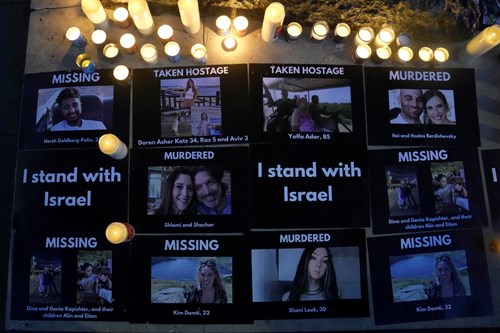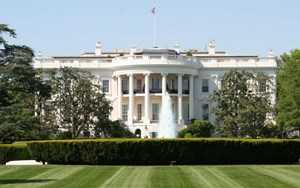The elaborate system of tunnels, by some estimates several kilometers underground and dating back to the 1960s, is short and cramped in many places. But not in the places occupied by Hamas senior command.
“The significance of this discovery of this particular maze of terror tunnels, is that these are the most important tunnels found so far,” regional analyst and All Israel News publisher Joel Rosenberg said on American Family Radio Wednesday. “Why? Because senior Hamas leaders had been in there. It was the underground bunker – or bunkers – of Hamas leaders.”
Rosenberg was among a small group of media that toured the now IDF-controlled spaces Sunday.
 “No one had ever seen this before, no other reporters, and they believe that Yahya Sinwar, the chief of Hamas, and his senior commanders had been there,” Rosenberg told show host Jenna Ellis.
“No one had ever seen this before, no other reporters, and they believe that Yahya Sinwar, the chief of Hamas, and his senior commanders had been there,” Rosenberg told show host Jenna Ellis.
Above ground journalists saw hundreds of apartment complexes, mosques and other buildings destroyed or severely damaged by Israeli forces. Why? Because every single one of them was used by Hamas terrorists to attack Israeli forces and to store machine guns, ammunition, rocket-propelled grenades, landmines and other weapons, wrote Rosenberg in his first-hand account for AllIsraelNews.com.
Below ground they saw half-filled glasses of juice and other evidence of recent activity. They saw tile on the flooring and walls and other privileges of rank.
It’s believed that Hamas chief Yahya Sinwar and his senior commanders had been there recently, Rosenberg said.
“Most tunnels are the sort that Hamas shock troops move through. They’re very narrow, not ornate, whatever sleeping quarters there are just straight concreate. Terrorists sleep on the floors and carry their weapons through in order to pop up some place, kill people, then go back underground,” Rosenberg said.
IDF believes Hamas leaders on the run
A strategic find like this illustrates that Hamas is on the run and feeling pressure from the IDF. The IDF reports that 75% of Hamas’ fighting force has been killed, severely wounded and taken out of battle, or captured.
The IDF believes it’s very close to gaining complete control of Khan Yunis, the largest city in Southern Gaza.
“It shows just how much the IDF is winning. They believe it’s safe enough to bring in journalists. Yes, there was machine-gun fire and explosions all around us, but it was safe enough. They feel like they’re within days, maybe a week, of controlling Khan Yunis. This means there aren’t many more places that Yahya Sinwar and the Hamas leadership can run,” Rosenberg said.

While there’s pressure on Hamas from IDF tanks and artillery, there’s pressure on Israeli Prime Minister Benjamin Netanyahu, too.
Netanhyu has consistently called for complete destruction of Hamas, a pledge he renewed at a Wednesday press conference saying victory is within reach.
Hamas began the war with a Saturday morning strike on Oct. 7 of last year when it killed more than 1,200 people and claimed 253 hostages.
During a temporary ceasefire, in November, Hamas released 105 civilians.
The Hamas-run Gaza health ministry says more than 27,000 Palestinians have died in the war.
A poll released by the Israel Democracy Institute in early January found that only 15% of Israelis want Netanyahu, 74, to remain in office after the war. There are allegations of corruption within his government, and he’s blamed for the security failures that led to the Hamas attacks, The New York Times reports.
 For now Bibi, as he’s widely known, pushes ahead for a victory he can almost feel, so he rejects the Hamas offer of a ceasefire.
For now Bibi, as he’s widely known, pushes ahead for a victory he can almost feel, so he rejects the Hamas offer of a ceasefire.
The conditions, reported by Reuters, would mean no Israeli forces in Gaza, freedom for Hamas-held hostages but also freedom for Palestinians held in Israeli jails – including 500 of Hamas’ choosing who have been sentenced for lengthy periods or for life.
“That’s asking Israel to surrender and that’s not going to happen,” Rosenberg said. “Prime Minister Netanyahu is of course saying, ‘There’s no way we’re going to surrender. We’re about to win.’”
Why Hamas wants a ceasefire now
The fact that Hamas is seeking peace now shows they’re in dire straits, Rosenberg said.
“Hamas hadn’t been talking for the last couple of months, and now they’re starting to talk," he reasoned. "But their deal is they want Israel to completely withdraw from the Gaza Strip.”
Netanyahu faces the challenge of threading the needle between victory and what most assume is diminishing health for the hostages.
“Their time is running out, their capacity to survive mentally and physically. How much more can they take? And remember, there are American citizens and several other nationalities also being held. The clock is ticking. There’s pressure inside Israel to make a deal,” Rosenberg said.







